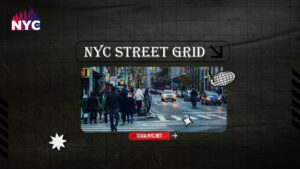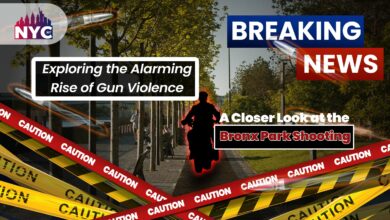Understanding NYC’s Street Grid: A History and Analysis

NYC Street Grid
NYC Street Grid is an infamous development impacting the lives of many.
New York City is famous for its iconic skyline, towering skyscrapers, and bustling streets. But have you ever wondered about the history and design behind the city’s street grid? NYC’s Street Grid has a fascinating story that dates back centuries to its Dutch origins. Today, it is one of the most efficient systems for navigating this global metropolis.
This blog post deeply dives into the following:
- Understanding NYC’s Street Grid
- A History and Analysis.
- its benefits to challenges,
- how it works
- criticisms surrounding it
Hence, get ready to broaden your knowledge of New York City like never before!
The Dutch Origins of the NYC Grid
The origins of the NYC grid can be traced back to the early 17th century when Dutch colonizers first landed on the island. The Dutch West India Company, which controlled New Amsterdam (later renamed New York), had a unique approach to urban planning based on efficiency and practicality.
In 1811, John Randel Jr., a surveyor appointed by city officials, created the current grid system. However, this concept had been introduced previously, drawing inspiration from earlier maps made by other surveyors.
Randel’s version was unique in its strict adherence to straight lines and right angles. This resulted in uniform blocks of land that could easily be sold or leased off for development purposes.
Interestingly, while Manhattan is known for its grid-like layout today, some areas, such as Greenwich Village, deviated from this pattern due to their pre-existing street networks before implementing the city-wide plan.
It’s fascinating how a small group of Dutch settlers laid the groundwork for one of America’s most iconic cities’ street design!

The NYC Grid Today
Today’s NYC grid is a testament to the city’s rich history and constant evolution. The city’s street grid system remains unchanged from its original layout in 1811, with numbered streets running east to west and avenues running north to south.
Despite some modifications over the years, such as adding diagonal avenues like Broadway, the grid has remained remarkably consistent. This consistency makes it easy for locals and tourists alike to navigate their way around the city.
However, maintaining such an extensive network of streets requires ongoing repairs and improvements. New York City’s Department of Transportation (DOT) holds more than 6,000 miles of roads throughout all five boroughs.
In recent years, there have been efforts by urban planners to make changes that would improve safety and sustainability on NYC’s busy streets. These include initiatives like Vision Zero aimed at reducing traffic fatalities through measures like lowering speed limits and redesigning intersections.
While some may criticize aspects of the NYC grid system, it remains a vital part of life in one of the world’s most vibrant cities.
How the NYC Street Grid Works
The NYC street grid is a marvel of urban planning that has been copied in cities worldwide. It comprises a network of streets and avenues intersecting at right angles, creating a rectangular pattern across Manhattan’s landscape.
This geometric layout makes it easy for drivers and pedestrians to navigate the city, as streets are numbered sequentially from east to west, and avenues run north-south. This system allows anyone to easily determine their location by looking at an address or cross street.
Additionally, the grid ensures that all parts of the city are easily accessible no matter where you are coming from. Thanks to this interconnectedness, New Yorkers can get anywhere they need to go quickly and efficiently.
Of course, there have been challenges with implementing such an extensive street plan over time. For example, some areas required buildings to be demolished for new roads or highways to be built – which caused significant displacement issues.
Despite these hurdles, it remains one of NYC’s defining features, serving locals and tourists who appreciate its logical organization and practicality when navigating one of America’s busiest cities.
The Criticisms of the NYC Street Grid
While the NYC street grid has numerous benefits, it’s not without its criticisms.
Difficulty in Navigating the City:
One of the most significant is that it can make navigating the city confusing and disorienting for those unfamiliar with the system.
Limited Urban Planning and Architecture:
Some argue that the rigid grid structure limits creative urban planning and architecture. Others point out that because all streets are built at right angles to each other, they don’t always take into account factors like topography or natural landmarks.
Despite these criticisms, there’s no denying that the NYC street grid has played a major role in shaping one of the world’s greatest cities.
Over time, it’s proven adaptable enough to accommodate changes in transportation technology while maintaining its basic structure.
As New York continues to evolve and grow, so will its iconic street grid, a reminder of our city’s past and a blueprint for its future development.
The Benefits of the NYC Grid
The NYC street grid has been a staple of the city since its inception in 1811. At the same time, it may seem like a mundane aspect of urban planning, but this grid has numerous benefits.
Easy Navigation:
Firstly, the grid system makes navigation straightforward. Streets run east to west while avenues run north to south, making it easy for anyone to navigate the city without getting lost.
Real estate opportunities
Additionally, the uniformity of the grid means that every block is roughly equal in size and shape. This allows for efficient use of space and maximizes real estate opportunities.
Better transportation Infrastructure:
The regularity of the NYC street grid also facilitates transportation infrastructure such as buses and subways. The consistent layout allows for easy placement of bus stops and subway entrances at regular intervals throughout the city.
Seamless tracking
Moreover, emergency services can easily locate buildings on any block due to their standardized numbering system. In times when every second counts during an emergency, this can prove invaluable in saving lives.
Encourages Pedestrian Activity
Finally, the NYC street grid encourages pedestrian activity by providing ample sidewalks along each block. Walking is one of the most common ways people get around New York City. Ultimately it promotes healthy habits among residents while reducing vehicular traffic congestion.
Hence, thanks to the NYC Street grid, people can now safely around the city. Consequently, it reduces pollution and promotes better health.
The Challenges of the NYC Grid
The NYC street grid has been around for almost two centuries. However, while it has many benefits, it also poses unique challenges.
Navigation of the Traffic:
One of the biggest challenges is navigating the city’s chaotic traffic. Drivers must navigate through a maze of intersections and one-way streets. Especially during rush hours with so many vehicles on the road.
Building Designs:
Another challenge posed by the NYC Grid is building design. Many buildings in New York City are long and narrow to fit within the confines of their specific block. This can make them challenging to renovate or repurpose since they often need more natural light sources.
Difficulty in Finding landmarks:
Newcomers to the city, who have yet to become familiar with these patterns, may find it difficult to find landmarks or specific addresses due to the uniform grid pattern in everything laid out.
Complete Isolation of Certain Sites:
Another area for improvement is that some sites may become isolated from others due to their location on different avenues or streets. For example, if you’re travelling from 2nd Avenue towards 3rd Avenue at an odd-numbered cross street like 13th Street, there might not be any path between those two Avenues due to a lack of connecting roads.
Despite these challenges, the grid remains integral to New York City’s character, history, and future development plans.
Conclusion
After exploring the following:
- history,
- benefits,
- challenges,
- and criticisms of NYC’s street grid system,
There is no simple answer to whether it is good or bad.
On the one hand, the grid allows for easy navigation and efficient transportation throughout the city. It also creates a sense of orderliness in a bustling metropolis. On the other hand, its rigidity can lead to monotony and lack of character in certain neighbourhoods.
Despite its flaws, however, there is no denying that the grid has played a significant role in shaping New York City as we know it today. It has influenced everything from urban planning to real estate development and cultural trends.
As with any complex system, there will always be room for improvement and innovation. The key is finding ways to balance practicality with creativity and adaptability.
In conclusion (despite not using those exact words), understanding NYC’s street grid requires an open-minded approach considering its strengths and weaknesses.
By doing so, we can appreciate this unique aspect of New York City’s identity while striving towards creating a more dynamic and livable urban environment for all residents.



